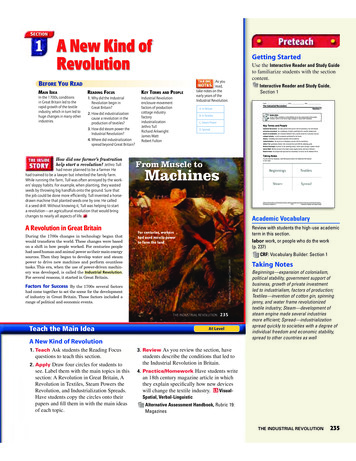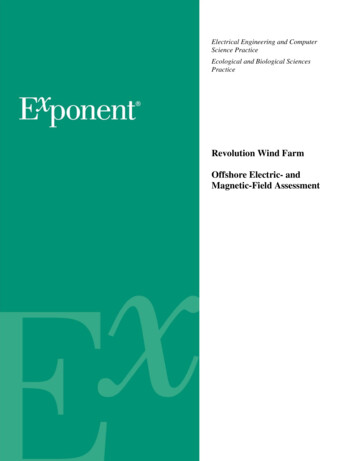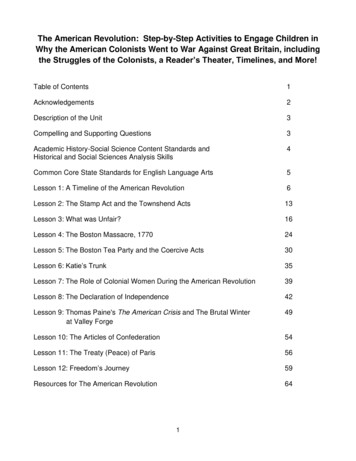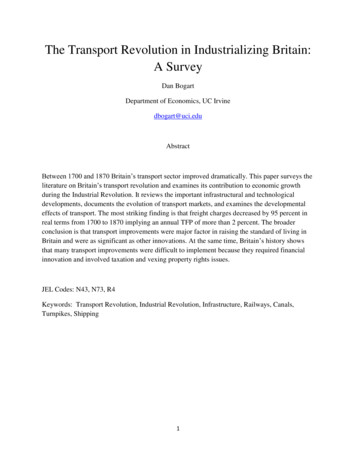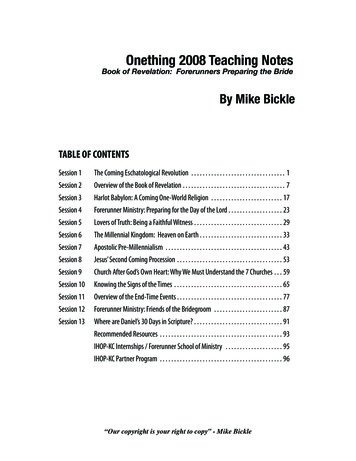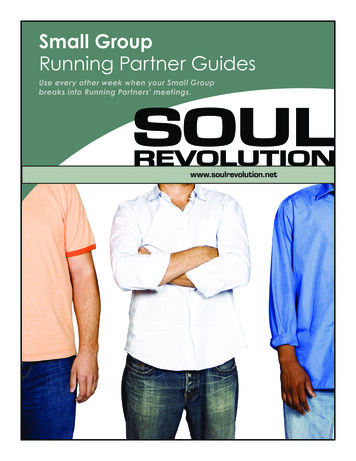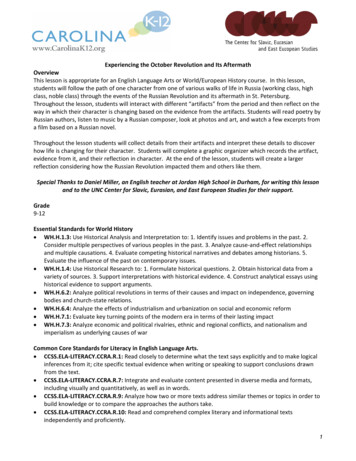
Transcription
Experiencing the October Revolution and Its AftermathOverviewThis lesson is appropriate for an English Language Arts or World/European History course. In this lesson,students will follow the path of one character from one of various walks of life in Russia (working class, highclass, noble class) through the events of the Russian Revolution and its aftermath in St. Petersburg.Throughout the lesson, students will interact with different “artifacts” from the period and then reflect on theway in which their character is changing based on the evidence from the artifacts. Students will read poetry byRussian authors, listen to music by a Russian composer, look at photos and art, and watch a few excerpts froma film based on a Russian novel.Throughout the lesson students will collect details from their artifacts and interpret these details to discoverhow life is changing for their character. Students will complete a graphic organizer which records the artifact,evidence from it, and their reflection in character. At the end of the lesson, students will create a largerreflection considering how the Russian Revolution impacted them and others like them.Special Thanks to Daniel Miller, an English teacher at Jordan High School in Durham, for writing this lessonand to the UNC Center for Slavic, Eurasian, and East European Studies for their support.Grade9-12Essential Standards for World History WH.H.1.3: Use Historical Analysis and Interpretation to: 1. Identify issues and problems in the past. 2.Consider multiple perspectives of various peoples in the past. 3. Analyze cause-and-effect relationshipsand multiple causations. 4. Evaluate competing historical narratives and debates among historians. 5.Evaluate the influence of the past on contemporary issues. WH.H.1.4: Use Historical Research to: 1. Formulate historical questions. 2. Obtain historical data from avariety of sources. 3. Support interpretations with historical evidence. 4. Construct analytical essays usinghistorical evidence to support arguments. WH.H.6.2: Analyze political revolutions in terms of their causes and impact on independence, governingbodies and church-state relations. WH.H.6.4: Analyze the effects of industrialism and urbanization on social and economic reform WH.H.7.1: Evaluate key turning points of the modern era in terms of their lasting impact WH.H.7.3: Analyze economic and political rivalries, ethnic and regional conflicts, and nationalism andimperialism as underlying causes of warCommon Core Standards for Literacy in English Language Arts. CCSS.ELA-LITERACY.CCRA.R.1: Read closely to determine what the text says explicitly and to make logicalinferences from it; cite specific textual evidence when writing or speaking to support conclusions drawnfrom the text. CCSS.ELA-LITERACY.CCRA.R.7: Integrate and evaluate content presented in diverse media and formats,including visually and quantitatively, as well as in words. CCSS.ELA-LITERACY.CCRA.R.9: Analyze how two or more texts address similar themes or topics in order tobuild knowledge or to compare the approaches the authors take. CCSS.ELA-LITERACY.CCRA.R.10: Read and comprehend complex literary and informational textsindependently and proficiently.1
CCSS.ELA-LITERACY.CCRA.W.2: Write informative/explanatory texts to examine and convey complex ideasand information clearly and accurately through the effective selection, organization, and analysis ofcontent.CCSS.ELA-LITERACY.CCRA.W.7: Conduct short as well as more sustained research projects based onfocused questions, demonstrating understanding of the subject under investigation.CCSS.ELA-LITERACY.CCRA.W.9: Draw evidence from literary or informational texts to support analysis,reflection, and research.Essential Questions How do different types of text reflect the same event? How are people and countries changed by moments in history? How are people connected to their histories?Materials The Russian Revolution PowerPoint, available in Carolina K-12’s Database of K-12 04/OctoberRevolutionPPT.pdf “Russian Revolution Graphic Organizer,” attached (p.6-8) 8 images related to the Russia Revolution, attached (p. 9-13)o Storming the Winter Palace Source: https://en.wikipedia.org/wiki/The Storming of the Winter PalaceoDemonstration in Petrograd Source: https://de.wikipedia.org/wiki/Februarrevolution 1917oGunned DownoMass AppealoTrashedoDesperate Source: 1681193,00.htmlo“To All Workers.” handbill, attached Source: nting Source: y-of-st-petersburg.html 5 Poems, attached (p. 14-18 )o“On Kulikovo Field” by AA Bloko“Patiently, as one grinds gravel ” by MI Tsvetaevao“I heard a voice. IT called, consoling” by AA Akhmatovao“From Street to Street” by VV Mayakovksyo“The Lost Tram” by NS Gumllev Poems Source: x.html Recording of Shostakovich Symphony, No. 2, Op, 14 “October” – Available for free via YouTube:ohttps://www.youtube.com/watch?v jPxm-uAkKLcoStudents will listen to the symphony on their own and will probably want to be set up at differentlistening stations so that they can skip through portions.oStudents can also access the YouTube clip on their smart phones and listen individually Film: Doctor Zhivago (1965) – You’ll show two clips to the students so you may want to have two differentbrowsers cued to the different moments. The students will watch from 17:00-40:00 and then from1:49:40-2:11:36. You can use the DVD of the film if available in your school’s media center or rent it onAmazon. “Reflections on the Russian Revolution” handout, attached (p. 19) “Brief Overview of the Russian Revolution” handout, attached (optional) (p. 20-21)oSource: http://www.history.com/topics/russian-revolution “Russia’s Big Revolution” video - Available for free via YouTube (optional)2
oohttps://www.youtube.com/watch?v TiyqklftoDcPlease note: teachers will want to view the video for age appropriateness before showing to class.Duration2 90-minute periods. In the first class, you’ll be exposing the students to the different artifacts (poems, images,etc.) and giving them time to study and interact with these artifacts in their groups. On the second day, thestudents will write their reflections and participate in an overall discussion.Teacher Preparation Print copies of the attached photos and poems for this lesson. Print a copy of the graphic organizer andreflection question for each student. Depending on your school’s technology resources find the most effective way to set up stations for yourstudents to interact with the film and audio stations. One suggestion would be to reserve a computer labfor the first day of the lesson and set up computers with the audio and set up other computers with thetwo film portions cued up. If you allow students to use smartphones in your class, share the YouTube link for the Recording ofShostakovich Symphony, No. 2, Op, 14 “October” and encourage students to listen individually or in theirsmall groups. Organize your students into groups of three – there should be one working class, one high class, and onemember of the nobility. Students may choose their own identities or they can be assigned. The identitieswill be discussed during the lesson opening. Create 5 learning stations. There will be a poetry station, a photo station, an audio station, and two filmstations. You will want to label the stations, especially the two film stations as “Before Revolution” and“After Revolution”, though this distinction should be clear to the students as they watch the film. At thefilm station, include a note that lists the time of the clips so students know where to begin and end. If teachers an unable to obtain multiple copies of the film Dr. Zhivago to set up two stations, play bothclips for the entire class and instruct students to complete their graphic organizers. At the conclusion ofboth clips, allow students to rotate through the rest of the stations with their groups. If teachers are unfamiliar with the film Dr. Zhivago, IMDB has a thorough plot sis?ref ttpl pl synStudent Preparation Optional Homework Assignments: If teachers would like to provide more background information orhistorical context for the Russian Revolution, choose one or both of the following activities:o Distribute the attached “Brief Overview of the Russian Revolution” reading from History.com andhave students read it and answer the questions.o Have students watch the “Russia’s Big Revolution” YouTube video and write down 10 things theylearned about the Russian Revolution. Please note: Teachers should view the video before assigningit to check f or age appropriateness. Optional: If students are are unfamiliar with the film Dr. Zhivago, IMDB has a thorough plot sis?ref ttpl pl synProcedure – Day OneWarm Up1. As a warmup, write the word REVOLUTION on the board and ask students to quietly to contemplate theterm. After a few minutes, ask students to share their ideas and organize those responses in the areaaround the word into PEOPLE, PLACES, IDEAS. Have the students brainstorm about revolutions to begintheir thinking and generate interest in the activity. When students come up with a person involved in arevolution, put that in people; for places where revolutions have occurred, identify that in places; forreasons why revolutions occur, place that in ideas. The teacher should at this point only ask leadingquestions like, “Who else ” or “Where else ” or “Why else ”.3
2. After allowing the students to generate ideas for about five to ten minutes, transition to the students tothe next term – RUSSIAN REVOLUTION. Hopefully students have listed Russia, equality, change ofgovernment, and possibly Lenin in the earlier activity. Students will construct a Know/Want toKnow/Learn (KWL) chart about the Russian Revolution. They will generate lists of what they already knowand want to learn about the Russian Revolution.Russian Revolution Rotating Stations3. Following the warm-up, distribute the attached Russian Revolution Graphic Organizer handout to eachstudent. Explain to students that they will be working in stations to experience the Russian Revolutionthrough poetry, photography, music, and film. They will study various artifacts in order to understand theRussian Revolution changed life for Russians across. If you have decided on roles for your students, tellthem who they are. If you have not identified roles for your students, allow them to choose which theywould like to be.4. Once students have their roles, project slides 2-4 from the Russian Revolution PPT, and review the basicbackground information about each class: working class, high class, and noble class. Once students havetheir roles determined, they will be placed in groups of three – in which each role is represented. Groupscan be larger than three, but all roles should be represented in each group.5. Next, review slide 5 – Questions to Consider – and instruct students to think about these questions as theyview each artifact. If possible, leave these questions projected as students complete the stations activity orprovide each group with a printout of the questions.6. Explain to students that they will have approximately 10-12 minutes at each station. Students should becompleting their graphic organizer as they rotate between each station. Inform students that If they are ina film or audio station they may skip through the audio or film clips to see/hear the various parts of theclip. For the images and the poems, they should record evidence from 3 of the photos and 2 of the poems.If they decide to collect more pieces of evidence, that is okay. Students should also reflect on how theirrole in society is changing as they travel through the various stations. Encourage students to discuss the“Questions to Consider” with their groupmates as they complete each station. Teachers should rotatethroughout the room to ensure that groups are staying on task and to answer any questions.7. Provide students with the rest of the class to rotate throughout the stations and complete their graphicorganizers. conclude the first day, make sure that the students have recorded evidence from each of theartifacts that they have studied. They should have finished all of the requirements including three photos,two poems, the film clips, and the symphony. Instruct the students that for homework they will want tomake sure to finish the application portion of the graphic organizer. They should also consider thereflection question at the end to help them with the application of the evidence to their role.Day 2Reflection and Wrap-Up8. After you have completed your beginning of class procedures, instruct the students to find their graphicorganizers from yesterday’s class as well as their “Know/Want to Know/Learned” charts from yesterday’swarm-up activity. Begin by having the students reflect independently on their KWL charts. Tell them that ifthere are more things that they know, to reflect that; if there are more things they want to know aboutfrom yesterday’s activity that they should put those down too; the most important thing is to considerwhat they learned.9. While the students are finishing their reflections on the KWL charts, move through the classroom andcheck the graphic organizers. Focus on the final column to make sure that students have done thorough4
preparation for the in-class writing assignment. If you see that students aren’t prepared or need additionalhelp you may want to form them into groups so that you can monitor and provide feedback or guidancefor those who may need more help.10. After you have finished checking the graphic organizers, engage the students in discussion about what theylearned from the previous class. Have them cite specific pieces of evidence that helped them to learnthose facts about the Russian Revolution. This will help to review yesterday’s class for the students andreengage them in their roles that they had for the activity.11. Following the discussion, provide students with the attached “Reflections on the Russian Revolution”handout. Review the instructions before allowing the students to work on their reflections. Studentsshould be given approximately fifty minutes to write. Teachers may choose to turn this into a full processassignment and use this as a rough draft development or to simply collect this and assign a grade with nofurther development.12. Collect the students’ work after they have had sufficient time to write. Collect the graphic organizer alongwith the reflections so that you are able to see the amount of information and preparation the studentshad done before completing their reflections. To conclude the lesson, discuss the questions on slide 6 ofthe PowerPoint. Focus your discussion on the questions that are more interesting and intriguing to youand your students.Optional Activities: Let students post their final reflections around the room and have them complete a gallery walk. Allowstudents to ask each other questions about their final reflections and then discuss the questions on slide 6. Have students take this online quiz to determine who they would support during the Russian Revolution.Some of the concepts and terms are intended for a people with a more comprehensive understanding ofthe Russian Revolution and Russian history, but the results can still be interesting for students to researchfurther.o http://arzamas.academy/materials/1269Additional Resources: UNC Center for Slavic, Eurasian, and East European Studieso http://cseees.unc.edu/ “British Library puts banned Bolshevik books on show in journey through Russian Revolution”o y-through-russian-revolution-a3525266.html “Tragedy or triumph? Russians agonise over how to mark 1917 revolutions”o ia-1917-revolutions-legacy-lenin-putin “History Hasn’t Killed It: The Story Behind ‘Doctor Zhivago’”o -50-anniversary5
Name:Russian Revolution Graphic OrganizerInstructions: As you interact with the different stations be sure to collect evidence and reflect on that evidence. What does this mean to you in yoursocial group? How are you being affected by the revolution as it is reflected in this piece of work? Remember to think through the lens of yourcharacter. Discuss with the other people you are working with how their experiences are similar or different.At the beginning of the Russian Revolution, I am a person.ArtifactEvidence from ArtifactWhat Do You Think It Means?What does it mean for your person?Image name/description of imageImage name/description of imageImage name/description of image6
Poem name/description of poemPoem name/description of poemfilm clip7
Film clipDescribe songWrite any additional notes or questions below8
Storming the Winter PalaceDemonstration in Petrograd9
Gunned ---------------------------Mass Appeal10
------------------------------Desperate11
12
1905 Red Revolution13
On Kulikovo FieldBy AA BlokThe river spreads out. It flows, sorrowful, lazyAnd washes the banks.Above the bare clay of the yellow cliffHaystacks languish on the steppe.O my Rus! My wife! Our long pathIs painfully clear!Our path has pierced our breast like an arrowOf ancient Tatar will.Our path leads through the steppe, through endless yearning,Through your yearning, O Rus!And I do not even fear the darknessOf night beyond the border.Let night come. We will speed to our goal, light upThe steppe with campfires.In the smoky reaches a holy banner will shineAlong with the Khan's steel sabre.And the battle is eternal! We can only dream of peaceThrough blood and dust.The mare of the steppe flies on and onAnd tramples the steppe grass.And there is no end! the miles and slopes flash by.Stop!The frightened thunderheads approach,The sunset bleeds!The sunset bleeds! Blood streams from the heart!Weep, heart, weep.There is no peace! The mare of the steppeFlies at full gallop!June 7, 190814
Patiently, as one grinds gravel .By MI TsvetaevaPatiently, as one grinds gravelPatiently, as one awaits death,Patiently, as news ripens,Patiently, as one savors revenge I will wait for you (fingers clinched Asa slave waits for his Queen)Patiently, as one waits for rhymes,Patiently, as one bites one's hands.I will wait for you (gaze to ground,Teeth to lips. Stupor. Stone).Patiently, as one prolongs bliss,Patiently, as one strings beads.The scrape of runners, the answering scrapeof a door: the roar of Taiga winds.A royal decree arrives:Coup d’état and the grandee is coming.Homeward bound:To the beyond Yet mine.27 March 192315
I heard a voice. It called, consoling By AA AkhmatovaI heard a voice. It called, consoling,It said to me: "Come hither, now.Abandon your forsaken, sinful land,Abandon Russia, leave forever.And from your hands I'll wash the blood,I'll draw the black shame from your heart,And with a new name I will cloakThe wounds of misery and loss."But I, dispassionate and calm,Concealed my ears beneath my hands,To hinder this unworthy speechFrom soiling my mournful soul.Autumn 191716
From Street to StreetBy VV MayakovksyThe boulevard.Bulldogsof yearsyour facesgrow steely.Steel horsessteal the first cubesjumping from the windowsof fleeting houses.Swanneckedbelfriesbend in electricwirenooses!The giraffehidesky unloosesmotley carrottopbangs.The sonof patternless fieldsis dappled like trout.Concealed by clocktower faces,a magicianpullsrails from the muzzle of a tram.We are enslaved!Baths.Showers.Elevatorselevatethe soul's bodice.Handsburnthe body.Cry all you may:"I didn't want it!" aropeburnof torment.From the chimneya whipping wind tearsa gray tuft of wool.A balding lamppostlustfully strips offthe street'sblack stocking.191317
The Lost TramBy NS GumilevI walked an unfamiliar streetAnd suddenly heard a raven's cry,And the sound of a lute, and distant thunder, Infront of me a tram was flying.How I jumped onto its foot board,Was a mystery to me,Even in daylight it left behindA fiery trail in the air.It rushed like a dark, winged storm,And was lost in the abyss of time.Tramdriver,stop,Stop the tram now.Too late. We had already turned the corner,We tore through a forest of palms,Over the Neva, the Nile, the SeineWe thundered across three bridges.And slipping by the window frame,A poor old man threw us an inquisitive glance Thevery same old man, of course,Who had died in Beirut a year ago.Where am I? So languid and troubledThe beat of my heart responds:"Do you see the station where you can buyA ticket to the India of the soul?"A sign.BloodfilledlettersAnnounce: "Zelennaya,"Iknow that hereInstead of cabbages and rutabagasThe heads of the dead are for sale.In a red shirt, with a face like an udder,The executioner cuts my head off, too,It lies together with the othersHere, in a slippery box, at the very bottom.And in a side street a board fence,A house three windows wide, a gray lawn.Tramdriver,stop,Stop the tram now.Mashenka, you lived here and sang,You wove me, your betrothed, a carpet,Where are your voice and body now,Is it possible that you are dead?How you groaned in your front chamber,While I, in a powdered wig,Went to introduce myself to the EmpressNever to see you again.Now I understand: our freedomIs only an indirect light from those times,People and shadows stand at the entranceTo a zoological park of planets.And a sudden, familiar, sweet wind blows,A horseman's hand in an iron gloveAnd two hooves of his horseFly at me over the bridge.That faithful stronghold of Orthodoxy,Isaac's, is etched upon the sky,There I will hold a service for Mashenka's healthAnd a requiem mass for myself.And my heart goes on forever in gloom,It is hard to breathe and painful to live.Mashenka, I never would have dreamedThat such love and longing were possible.18
NameReflections on the Russian RevolutionDirections: After completing your graphic organizer, imagine that you are someone from yourassigned class (working class, high class, noble class). Putting yourself in that person’s shoes, answerthe question: how was your assigned character affected by the Russian Revolution?To answer that question, you may choose one of the following formats: A standard 5 paragraph essay with a one paragraph introduction, 3 paragraphs of supportingevidence, and a one paragraph conclusion. A series of personal journal or diary entries that describe your life how it was affected by theRussian Revolution A graphic novel that describes your life and how it was affected by the Russian Revolution A series of poems that describe your life and how it was affected by the Russian Revolution A short video interview or narrative that describes your life and how it was affected by theRussian Revolution. A format of your choosing that has been approved by your teacher.Regardless of what format you choose, you must cite evidence from the various stations and/or othermaterials provided by your teacher (readings, videos, websites, etc.) in your final reflection.Due ions on the Russian RevolutionDirections: After completing your graphic organizer, imagine that you are someone from yourassigned class (working class, high class, noble class). Putting yourself in that person’s shoes, answerthe question: how was your assigned character affected by the Russian Revolution?To answer that question, you may choose one of the following formats: A standard 5 paragraph essay with a one paragraph introduction, 3 paragraphs of supportingevidence, and a one paragraph conclusion. A series of personal journal or diary entries that describe your life how it was affected by theRussian Revolution A graphic novel that describes your life and how it was affected by the Russian Revolution A series of poems that describe your life and how it was affected by the Russian Revolution A short video interview or narrative that describes your life and how it was affected by theRussian Revolution. A format of your choosing that has been approved by your teacher.Regardless of what format you choose, you must cite evidence from the various stations and/or othermaterials provided by your teacher (readings, videos, websites, etc.) in your final reflection.Due Date:19
BRIEF OVERVIEW OF THE RUSSIAN REVOLUTIONIn 1917, two revolutions swept through Russia, ending centuries of imperial rule and setting in motion politicaland social changes that would lead to the formation of the Soviet Union. In March, growing civil unrest,coupled with chronic food shortages, erupted into open revolt, forcing the abdication of Nicholas II (18681918), the last Russian czar. Just months later, the newly installed provisional government was itselfoverthrown by the more radical Bolsheviks, led by Vladimir Lenin (1870-1924).RUSSIAN REVOLUTION: BACKGROUNDBy 1917, most Russians had lost faith in the leadership ability of Czar Nicholas II. Government corruption wasrampant, the Russian economy remained backward, and Nicholas repeatedly dissolved the Duma, the Russianparliament established after the 1905 revolution, when it opposed his will. However, the immediate cause ofthe February Revolution–the first phase of the Russian Revolution of 1917–was Russia’s disastrousinvolvement in World War I (1914-18). Militarily, imperial Russia was no match for industrialized Germany, andRussian casualties were greater than those sustained by any nation in any previous war. Meanwhile, theeconomy was hopelessly disrupted by the costly war effort, and moderates joined Russian radical elements incalling for the overthrow of the czar.FEBRUARY REVOLUTION: 1917The February Revolution (known as such because of Russia’s use of the Julian calendaruntil February 1918) began on March 8, 1917 (or February 23 on the Julian calendar),when demonstrators clamoring for bread took to the streets in the Russian capital ofPetrograd (now called St. Petersburg). Supported by huge crowds of striking industrialworkers, the protesters clashed with police but refused to leave the streets. On March10, the strike spread among all of Petrograd’s workers, and irate mobs destroyedpolice stations. Several factories elected deputies to the Petrograd Soviet, or council,of workers’ committees, following the model devised during the 1905 revolution.VI LeninOn March 11, the troops of the Petrograd army garrison were called out to quell the uprising. In someencounters, regiments opened fire, killing demonstrators, but the protesters kept to the streets and the troopsbegan to waver. That day, Nicholas again dissolved the Duma. On March 12, the revolution triumphed whenregiment after regiment of the Petrograd garrison defected to the cause of the demonstrators. The soldierssubsequently formed committees that elected deputies to the Petrograd Soviet.The imperial government was forced to resign, and the Duma formed a provisional government that peacefullyvied with the Petrograd Soviet for control of the revolution. On March 14, the Petrograd Soviet issued OrderNo. 1, which instructed Russian soldiers and sailors to obey only those orders that did not conflict with thedirectives of the Soviet. The next day, March 15, Czar Nicholas II abdicated the throne in favor of his brotherMichael (1878-1918), whose refusal of the crown brought an end to the czarist autocracy.20
BOLSHEVIK REVOLUTION: 1917In the aftermath of the February Revolution, power was shared between the weak provisional government andthe Petrograd Soviet. Then, on November 6 and 7, 1917 (or October 24 and 25 on the Julian calendar, which iswhy this event is also referred to as the October Revolution), leftist revolutionaries led by Bolshevik Partyleader Vladimir Lenin launched a nearly bloodless coup d’état against the provisional government. TheBolsheviks and their allies occupied government buildings and other strategic locations in Petrograd, and soonformed a new government with Lenin as its head.Lenin became the virtual dictator of the first Marxist state in the world. His government made peace withGermany, nationalized industry and distributed land, but beginning in 1918 had to fight a devastating civil waragainst anti-Bolshevik White Army forces. In 1920, the anti-Bolsheviks were defeated, and in 1922 the Union ofSoviet Socialist Republics (USSR) was established.Source: rintAnswer the following questions after reading:1. What helped cause the February Revolution?2. Why do you think Czar Nicholas II abdicated the throne? What was the result of this action?3. Who was Vladimir Illich Lenin?4. Why do you think the Bolsheviks were successful in overthrowing the provisional government?5. What do you think happened to Russia after the USSR was established?21
Know/Learn (KWL) chart about the Russian Revolution. They will generate lists of what they already know and want to learn about the Russian Revolution. Russian Revolution Rotating Stations 3. Following the warm-up, distribute the attached Russian

